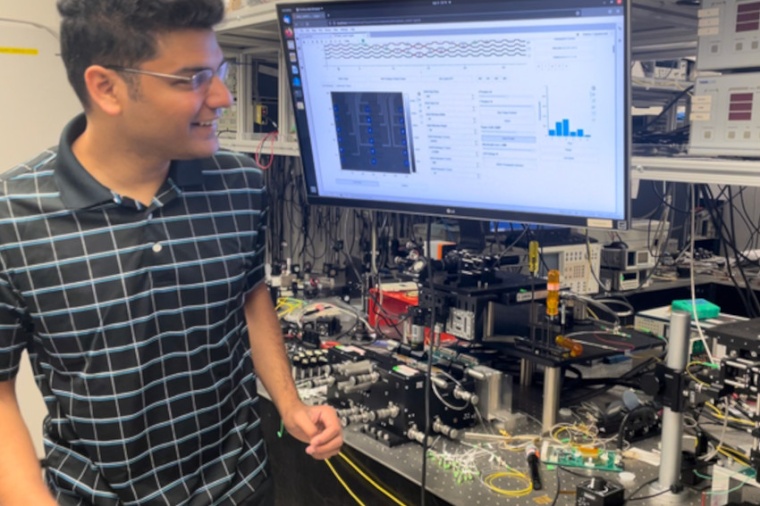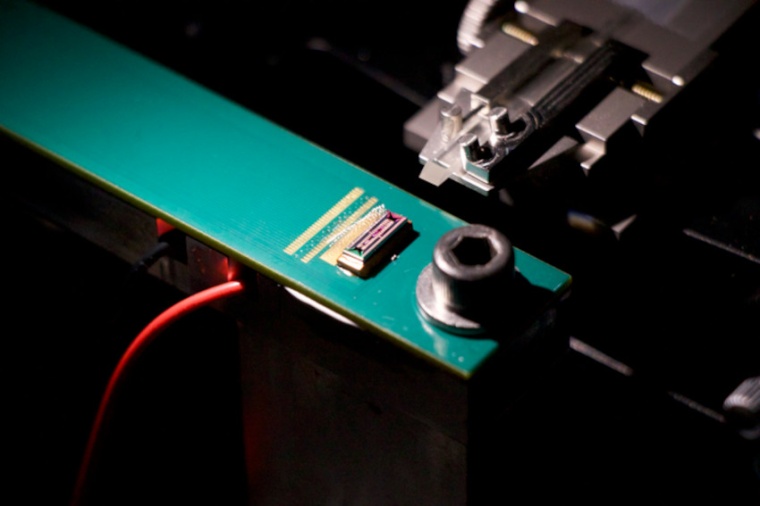Photonic blockchain by low-energy optical computing
Light-based computing scheme reduces power needed to mine cryptocurrencies.
Researchers have developed a new light-based computing scheme that uses a photonic integrated circuit to reduce the energy necessary for cryptocurrency and blockchain applications. Mining cryptocurrencies like Bitcoin consumes up to 1 percent of the world’s energy. This energy expenditure is expected to grow as cryptocurrency and blockchain applications become increasingly mainstream.


“Currently, cryptocurrency mining is only accessible to those that have access to highly discounted energy – below $0.05/kWh,” said Sunil Pai, who performed the research at Stanford and is now at the quantum computing company PsiQuantum. “Our low-energy chips will make it possible for individuals all over the world to participate in mining profitably.” The researchers call their new scheme LightHash, which uses a photonic integrated circuit to create a photonic blockchain. With further development, the researchers predict that this approach, if implemented on a large scale, could produce a roughly ten-fold improvement in energy use compared to the best modern digital electronic processors. David A.B. Miller co-led the Stanford University research team with Shanhui Fan and Olav Solgaard.
“Our approach to photonic blockchain could also be used for applications beyond cryptocurrency such as securely transferring data for medical records, smart contracts and voting,” said Pai. “This work paves the way for low-energy optical computing, which, ultimately, can reduce data centers’ energy consumption.” Growing concerns about the large amount of energy required to mine cryptocurrencies have caused some popular ones such as Ethereum to shift to unproven and potentially insecure schemes to minimize their carbon footprint.
To find a more eco-friendly approach while maintaining a high level of security, Pai and colleagues use silicon photonics to reduce the energy requirements of cryptocurrency networks. LightHash improves upon a scheme the team previously developed called HeavyHash that is currently used in cryptocurrency networks such as Optical Bitcoin and Kaspa. “The major motivation for LightHash was HeavyHash’s high sensitivity to hardware error,” said Pai. “Since analog computers, including photonic ones, struggle to achieve low error rates, we designed LightHash to maintain all the security properties of HeavyHash, while improving its robustness to error.”
Securely creating Bitcoin or operating its computing network requires computing a hash function like SHA256 or Heavyhash to transform input data into a single output number in a way that is too complex to be undone, which accounts for the bulk of Bitcoin’s energy use. In the new work, the researchers modified Heavyhash to work with a co-designed silicon photonic chip carrying a 6x6 network of programmable interferometers. This enabled low-energy optical processing of matrix multiplications, which forms the bulk of the computation in Lighthash. To evaluate the feasibility of using LightHash for matrix multiplication, the researchers built an optical rig to control and track the propagation of light by tuning heating elements and imaging grating spots onto an infrared camera. They also implemented an error mitigation algorithm and established feasibility criteria for scaling the technology.
The experimental results achieved with the silicon photonic chip matched those obtained using simulated error predictions. “Our results suggest that LightHash can be feasibly computed at scale using current silicon photonic chip technology,” said Pai. “Essentially, we have devised a way to use analog optical circuits to perform multiplications at near zero power dissipation yet precisely enough for use in a digital encryption scheme.” For LightHash to demonstrate considerable advantages over digital equivalents, it must be scaled up to 64 inputs and outputs. The researchers are also working to further reduce energy consumption by designing low-power electromechanical tuning elements and energy-efficient converters to turn the optical signals into electrical signals.
They say that because the new chip accelerates matrix multiplication, the most computationally intensive operation for AI applications, it could also help make training and application of photonic neural networks more energy efficient compared to conventional digital implementations. “It will be interesting to see how cryptocurrency technology evolves and to what extent photonics can contribute to the increasingly mainstream role of decentralized ledgers in society today,” said Pai. (Source: Optica)
Link: Ginzton Lab, Dept. of Electrical Engineering, Stanford University, Stanford, USA
most read

SEW-Eurodrive and TTTech Digital Solutions enter into partnership
The aim of the collaboration is to integrate SEW-Eurodrive's axis and drive systems into the Ubique automation platform.

HMS Networks takes over Industrial Communications division from Molex
This strategic acquisition includes intellectual property in hardware and software, a product portfolio with network cards and software stacks, as well as customer relationships in the USA and Japan.

Laser Components: customized laser optics since 1986
Laser Components began coating individual laser optics almost 40 years ago. These are used in laser processes in numerous industries, including medicine, defense and aerospace.

First access for external users to the QSolid quantum computer
The prototype of the QSolid quantum computer was successfully integrated into the JUNIQ infrastructure of the Jülich Supercomputing Center.

Change in management at Stemmer Imaging: Arne Dehn steps down
New interim CEO Paul Scholten takes over management






